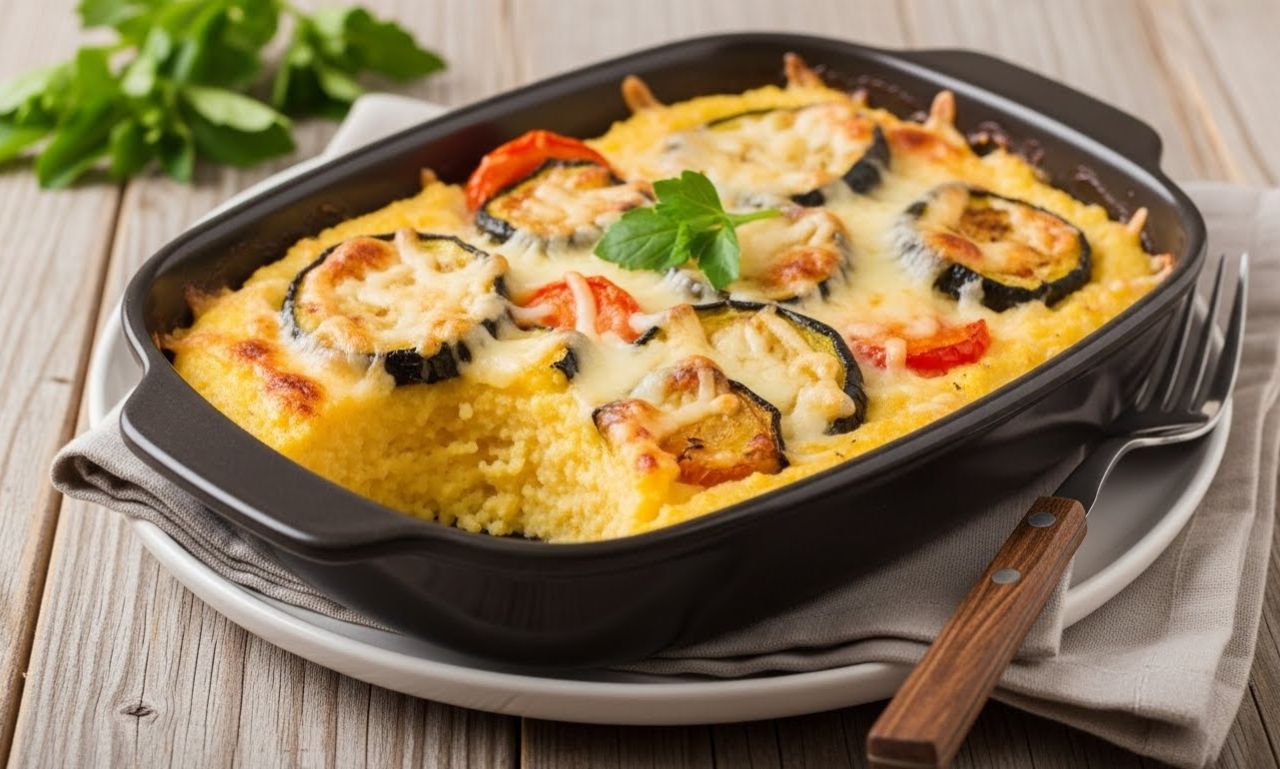Food
Palentu: The Versatile Dish That Transcends Borders

Imagine a dish so versatile that it bridges cultures and tantalizes taste buds around the globe. Enter palentu, a culinary gem that has found its way into kitchens from Italy to Africa, each region adding its unique flair. Whether enjoyed as a comforting side or transformed into an exquisite entrée, palentu is more than just food; it’s an experience steeped in tradition and innovation. Join us on a flavorful journey through the origins, variations, and modern interpretations of this beloved dish. Get ready to discover why palentu deserves a spot on your plate!
What is Palentu?
Palentu is a delightful dish made primarily from cornmeal. Its texture can be creamy or firm, depending on how it’s prepared. This versatility allows for an array of culinary applications.
Often served as a side, palentu acts like a blank canvas for flavors. It pairs well with meats, sauces, and vegetables, absorbing their tastes beautifully.
This humble dish has roots in many cultures around the globe. Each region adds its unique twist, making palentu not just food but also a cultural experience.
In essence, palentu showcases simplicity while encouraging creativity in the kitchen. Whether enjoyed plain or dressed up with gourmet toppings, it’s always satisfying and comforting to eat.
The Origins and History of Palentu
Palentu has a rich history that stretches back centuries. Its roots can be traced to various cultures across Europe, Africa, and South America. This humble dish began as a staple for many communities, often made from ground grains or corn.
In Italy, palentu is known as polenta and served alongside meat dishes. Similarly, in parts of West Africa, it takes the form of a thick porridge called fufu. Each region brings its unique twist to this versatile food.
Historically significant during times of scarcity, palentu provided nourishment when resources were limited. It became more than just sustenance; it evolved into comfort food cherished by families.
As trade routes expanded and culinary practices mingled, variations emerged globally. The adaptability of palentu reflects not only local ingredients but also cultural influences over time.
Ingredients Used in Palentu
The magic of palentu lies in its ingredients. At its core, this dish is made from cornmeal, a staple that brings a comforting texture and flavor.
Water or broth provides the necessary moisture. It helps transform dry cornmeal into a creamy base that’s both rich and inviting.
Salt adds just the right amount of seasoning, enhancing the natural flavors without overpowering them. Some variations incorporate butter or oil for additional richness.
Herbs and spices can elevate palentu further, introducing unique twists based on regional preferences. Think garlic for warmth or pepper for a kick.
Cheese is another beloved addition, melting beautifully to create a decadent layer on top. The possibilities are endless! Each ingredient contributes to making palentu not only versatile but also deeply satisfying in every bite.
Traditional Variations of Palentu Across Different Cultures
Palentu showcases remarkable versatility, adapting beautifully to various cultural palates. In Italy, it becomes polenta—a creamy staple often paired with rich sauces or grilled meats. Its comforting warmth makes it a beloved dish at family gatherings.
Traveling south to Brazil, we find a corn-based delight known as “angu.” Traditionally served alongside stews and hearty meals, this variation incorporates local spices for an enticing flavor profile.
In West Africa, palentu takes on unique forms like “fufu.” This version is pounded until smooth and stretchy, often enjoyed with soups or savory dishes.
Across the Mediterranean in Greece, “kolokithopita” features palentu wrapped in flaky pastry layers filled with zucchini and cheese—an exquisite balance of textures and tastes.
These variations reflect regional ingredients and culinary traditions while celebrating the essence of palentu. Each culture adds its twist making this humble dish truly universal.
Modern Takes on Palentu: Fusion and Gourmet Versions
Modern culinary trends have embraced palentu, transforming it into a canvas for creativity. Chefs worldwide are infusing this beloved dish with global flavors and innovative techniques.
Imagine palentu served in a sushi roll, wrapped around fresh vegetables and seafood, merging Italian comfort with Japanese precision. In upscale restaurants, you can find expertly paired with truffle oil and wild mushrooms, elevating its rustic charm to gourmet status.
Street food vendors are also getting in on the action. They serve loaded palentu bowls topped with spicy salsas or rich cheeses that reflect local tastes while keeping the essence of this versatile dish intact.
From sweet variations featuring fruits and honey to savory options sprinkled with herbs and spices, modern takes on palentu highlight its adaptability. Every bite tells a story of fusion—one that connects cultures through shared ingredients and experiences.
Health Benefits of Eating Palentu
Palentu is not just a delicious dish; it’s also packed with health benefits that make it a great addition to your diet. Made primarily from cornmeal, is rich in complex carbohydrates. This means it provides a steady source of energy without causing spikes in blood sugar.
Furthermore, palentu contains essential vitamins and minerals like vitamin B6, iron, and magnesium. These nutrients support various bodily functions, from metabolism to muscle function.
Being gluten-free makes an excellent choice for those with gluten sensitivities or celiac disease. Its versatility allows it to be paired with numerous ingredients—vegetables, meats, or sauces—enhancing its nutritional profile even further.
Additionally, the fiber content in palentu aids digestion and promotes gut health. Enjoying this dish can help keep you feeling full longer while supporting weight management efforts as well.
How to Make Your Own Palentu at Home
Making your own palentu at home is quite simple and rewarding. Start with the right ingredients: cornmeal, water, and a pinch of salt.
Begin by bringing water to a boil in a saucepan. For every cup of cornmeal, use about three cups of water to achieve that perfect consistency.
Once the water is bubbling, slowly whisk in the cornmeal while stirring constantly to prevent lumps from forming. Reduce the heat and continue cooking for around 15-20 minutes until it thickens up nicely.
When it’s done, pour it into a greased dish or mold to set. Let it cool before slicing into pieces. You can serve palentu warm or allow it to firm up further for grilling or frying later on.
Experiment with toppings like cheese, herbs, or sautéed vegetables for added flavor! Enjoy personalizing this versatile dish according to your taste buds.
Where to Find the Best Palentu Around the World
Traveling the globe in search of palentu can be a delightful culinary adventure. Each region boasts its own unique spin on this versatile dish.
In Romania, local markets often feature stalls serving steaming bowls of polenta topped with sour cream and cheese. This traditional preparation is not to be missed.
Head over to Italy, where you’ll find creamy polenta served alongside rich ragù or sautéed mushrooms. Many trattorias offer it as a comforting side dish that pairs beautifully with robust flavors.
For those venturing into South America, Brazil’s “polenta frita” is a crispy treat enjoyed at street food stands. It’s perfect for snacking while exploring vibrant city life.
Do not overlook the cozy cafés in Slovenia, where you’ll encounter variations infused with herbs or spices that reflect local ingredients. Each bite tells a story about place and culture, making every experience memorable.
Why You Should Try
Palentu is not just food; it’s an experience. With its rich flavors and comforting texture, this dish invites you to explore a tapestry of cultures.
Trying opens doors to culinary traditions that span continents. Each bite tells a story, connecting you with diverse histories and lifestyles.
It’s customizable too! Whether you prefer savory or sweet, there’s a version for everyone. You can experiment with spices, toppings, and sides to make it your own.
Palentu is also incredibly satisfying. The warmth it brings can transform any meal into a cozy gathering moment.
Sharing palentu with friends or family creates memories that linger long after the last bite has been enjoyed. Embrace the versatility of this timeless dish. You might just find your new favorite comfort food in every serving!
Conclusion
Palentu is more than just a dish; it’s a culinary journey that embraces diverse cultures and traditions. Its adaptability allows it to shine in both humble kitchens and gourmet restaurants. Whether enjoyed as comfort food or dressed up with modern flair, invites everyone to savor its rich flavors.
Exploring the origins and variations across different regions reveals how this dish transcends borders. From traditional recipes passed down through generations to innovative fusion versions, palentu can cater to various tastes and preferences.
The health benefits associated with make it an appealing choice for those seeking nutritious options without sacrificing flavor. Plus, making your own at home opens doors for creativity in the kitchen.
Wherever you are in the world, there’s bound to be a delightful version of waiting for you to discover. With so many reasons to try this versatile dish, it’s time to indulge in its deliciousness and experience the magic of palentu firsthand.
Food
Cevurı: Discovering Regional Twists on a Classic Dish

Cevurı is more than just a dish; it’s a flavorful journey through the culinary traditions of various regions. Picture this: tender meats, vibrant spices, and unique cooking techniques all coming together to create something truly special. Originating from rich cultural backgrounds, cevurı has evolved over time, showcasing regional flair that makes each version distinct. Whether you’re a seasoned foodie or simply curious about global flavors, exploring cevurı opens up a world of taste experiences waiting to be discovered. Let’s dive into what makes this dish so captivating!
What is Cevurı?
Cevurı is a delightful dish that embodies the heart of regional culinary traditions. At its core, it features tender meat, often lamb or beef, marinated and cooked to perfection.
The preparation involves slow-cooking in rich spices and herbs. This creates an explosion of flavors that tantalize the taste buds. Each region adds its own flair, making cevurı a canvas for creativity.
Typically served with fresh vegetables or aromatic rice, cevurı becomes more than just a meal; it’s an experience. People share stories around the table while enjoying this satisfying dish.
Whether enjoyed at a family gathering or during festive occasions, cevurı holds a special place in many hearts. Its aroma alone can evoke nostalgia and warmth from childhood memories spent with loved ones.
Regional variations of Cevurı
Cevurı is a dish that beautifully adapts to local tastes and ingredients, making each variant a delightful experience. In coastal regions, seafood often takes center stage. Fresh fish or shrimp may replace the traditional meats, infused with zesty herbs straight from nearby gardens.
Traveling inland, you might encounter heartier versions featuring lamb or beef. These preparations typically include rich spices that reflect agricultural traditions of the area.
In some mountainous regions, Cevurı incorporates wild mushrooms or foraged greens. The earthy flavors add depth and showcase local biodiversity.
Each region’s unique twist on cevurı tells a story of its culture and culinary heritage. Whether it’s through technique or ingredient selection, these variations celebrate community connections while inviting everyone to explore this beloved dish in new ways.
Traditional ingredients used in different versions of Cevurı
Cevurı is a celebration of flavors, with each region adding its own flair through traditional ingredients.
In the heart of Anatolia, you might find robust spices like cumin and paprika infused into the mix. These create a warm, aromatic base that lingers on your palate.
Head to the coastal areas, and seafood takes center stage. Fresh fish or shrimp often replace meat in these versions, bringing a touch of brininess that perfectly balances rich sauces.
Vegetarian variations shine bright as well. In some regions, eggplant and bell peppers are essential players. Their smoky essence adds depth to every bite.
Moreover, herbs like parsley and mint frequently make an appearance. They lend freshness that contrasts beautifully with richer elements in the dish.
Each ingredient tells a story about local culture and tastes while honoring this beloved classic dish called cevurı.
How to Make a Basic Cevurı Dish
Creating a basic cevurı dish is surprisingly easy. Start with fresh, high-quality ingredients for the best flavor.
Begin by gathering your base—typically rice or bulgur. Cook it according to package instructions until fluffy.
Next, choose your protein. Chicken, beef, or even lentils work wonderfully here! Sauté the protein in olive oil with chopped onions and garlic until browned.
Now it’s time to add spices. Cumin, paprika, and salt are classic choices that elevate the dish’s taste profile.
Stir in diced tomatoes and bell peppers for a burst of color and freshness. Let this mixture simmer for about 10 minutes so all the flavors meld beautifully.
Combine your cooked base with the sautéed mixture. Garnish with fresh parsley or cilantro before serving warm on a plate or in bowls! Enjoy experimenting as you make this beloved culinary staple uniquely yours.
Unique twists on traditional Cevurı recipes
Cevurı has a way of inspiring creativity in the kitchen. Chefs and home cooks alike are experimenting with flavors that elevate this classic dish.
One exciting variation incorporates roasted red peppers for a smoky depth. The peppers add color and an unexpected sweetness that pairs beautifully with traditional spices.
Another twist involves using quinoa instead of rice, making it gluten-free and packed with protein. This version caters to health-conscious diners while maintaining the essence of cevurı.
For those craving something spicy, adding jalapeños or harissa can ignite your taste buds. It provides a kick without overshadowing the original profile.
Don’t forget dessert-inspired cevurı! Imagine sweetened coconut or chocolate-infused variations served alongside fruit compote—a delightful fusion worth trying.
Each interpretation opens up possibilities, showcasing how versatile this beloved dish truly is.
Pairing suggestions for Cevurı
When it comes to enjoying cevurı, the right pairings can elevate your experience. A chilled glass of ayran complements the dish beautifully. Its creamy texture and tanginess balance the flavors perfectly.
For those who prefer something with a kick, try pairing cevurı with a spicy red pepper sauce. The heat enhances the savory notes in each bite.
Fresh salads also make great companions. A zesty tabbouleh or crisp cucumber salad provides a refreshing contrast that brightens up this rich dish.
If you’re looking for something heartier, consider serving cevurı alongside fluffy rice pilaf or warm pita bread. Both options soak up juices wonderfully, making every mouthful delightful.
Don’t forget dessert! A light baklava drizzled with honey adds just the right sweet touch to round off your meal after savoring this classic treat.
The versatility and cultural significance of Cevurı
Cevurı is more than just a dish; it embodies the spirit of celebration and community. Found at family gatherings, local festivals, and street fairs, this culinary delight brings people together.
Its versatility shines through in various regional adaptations. Each locality adds its unique flair, showcasing local ingredients and cooking techniques. This adaptability makes cevurı a canvas for creativity.
Beyond its taste, cevurı carries cultural significance as a reflection of heritage. It tells stories passed down through generations, connecting families to their roots.
In many cultures where cevurı thrives, it’s often associated with traditions that celebrate life’s milestones—weddings, birthdays or even casual weekend get-togethers. Its presence signifies warmth and hospitality.
As more people discover this delightful dish, it continues to evolve while retaining its deep-seated cultural ties. The love for cevurı transcends borders and unites diverse communities in appreciation of shared flavors.
Conclusion
Cevurı is more than just a dish; it’s a celebration of culinary heritage. With its origins steeped in tradition, this delightful meal showcases the rich tapestry of flavors that different regions bring to the table. Each variation offers its own unique spin, allowing for endless creativity and adaptation.
The traditional ingredients used in cevurı lend themselves to experimentation while still honoring their roots. From fresh vegetables to diverse spices, every bite tells a story. As you explore ways to make your basic cevurı dish or try out unique twists on classic recipes, you’ll find it’s an experience as much as it is about taste.
Pairing cevurı with complementary sides can elevate your dining experience even further. Whether you’re enjoying it at home or during cultural celebrations, this dish carries significant meaning and versatility across various settings.
Embracing cevurı means diving into a world where food connects people through flavor and shared history. The next time you enjoy a plate of this delicious meal, remember that each bite reflects not only regional flair but also the warmth of community traditions woven into every recipe passed down through generations.
Food
Masgonzola: Why This Cheese Deserves a Place in Your Diet

If you’re a cheese lover, you know there are countless varieties to explore. But have you heard of Masgonzola? This unique cheese is making waves in the culinary world and deserves your attention. With its rich history, distinct flavor profile, and impressive nutritional benefits, Masgonzola is not just another block of cheese—it’s an experience waiting to be savored. Whether you’re adding it to a gourmet dish or enjoying it on its own, this delightful cheese has something special to offer everyone. Let’s dive into what makes Masgonzola stand out in the vast universe of cheeses!
What is Masgonzola?
Masgonzola is a delightful cheese that hails from Italy, specifically the Lombardy region. This semi-soft cheese boasts a creamy texture and is known for its rich, nutty flavor profile.
Unlike traditional blue cheeses, Masgonzola has a milder taste with subtle tangy notes. It’s made from cow’s milk and features characteristic blue-green marbling created by the Penicillium mold during aging.
The distinct aroma sets it apart. When you first encounter Masgonzola, you’ll notice an inviting scent that hints at its complexity without overwhelming your senses.
This cheese can be enjoyed on its own or as part of various dishes. Its versatility makes it popular among chefs and home cooks alike who appreciate high-quality ingredients in their recipes. Whether crumbled over salads or melted into sauces, Masgonzola brings depth to any meal experience.
History and origin of Masgonzola
Masgonzola has its roots deeply embedded in the rich cheese-making traditions of Italy. This delightful cheese hails from the northern region, particularly Lombardy and Piedmont, where artisanal practices have flourished for centuries.
The creation of Masgonzola is often credited to local farmers who sought to craft a blue-veined cheese that would stand out among others. Its unique characteristics began evolving during the 19th century when cheesemakers experimented with cultures and aging techniques.
As it gained popularity, Masgonzola started making its way beyond Italian borders. Today, it’s cherished worldwide not just for its flavor but also for its cultural heritage. Each bite carries a story steeped in tradition and craftsmanship.
Nutritional benefits of Masgonzola
Masgonzola is not just delicious; it’s also packed with nutritional benefits. This cheese contains a good amount of protein, essential for muscle repair and growth.
It also boasts calcium, which plays a crucial role in maintaining strong bones and teeth. Incorporating masgonzola into your diet can help meet your daily calcium needs.
Rich in vitamins A and B12, masgonzola supports eye health and boosts energy levels. These vitamins are vital for overall well-being.
The presence of beneficial fats in this cheese can aid in nutrient absorption while providing satiety, making it easier to manage hunger throughout the day.
Moreover, masgonzola has probiotics that promote gut health. These friendly bacteria contribute to better digestion and may strengthen your immune system as well.
How Masgonzola compares to other types of cheese
Masgonzola stands out among cheeses due to its distinctive flavor profile. Unlike the milder Gorgonzola, offers a robust taste that can elevate dishes in unexpected ways.
When compared to classic cheddar, Masgonzola has a creamier texture and a slightly tangy finish. This makes it an excellent candidate for sauces or spreads, where cheddar might be too sharp.
In contrast to feta’s crumbly nature, maintains a smooth consistency that melts beautifully. This quality enhances pizzas and pastas alike, providing richness without overwhelming other ingredients.
The aging process also sets Masgonzola apart from softer cheeses like brie. Its maturation develops deep flavors while keeping the cheese sliceable yet spreadable—perfect for charcuterie boards or gourmet sandwiches.
Each cheese brings something unique to the table, but few can match the versatility and character of Masgonzola in culinary adventures.
Ways to incorporate Masgonzola into your diet
Masgonzola adds a rich flavor to many dishes. Try crumbling it over your favorite salad for an extra burst of taste. It pairs well with fresh greens and fruits like pears or figs.
For a comforting twist, melt into creamy pasta sauces. The cheese’s unique tanginess enhances the overall dish, creating something special.
Consider blending into dips or spreads for entertaining guests. Combine it with cream cheese and herbs for a delightful appetizer served with crackers or vegetables.
If you’re feeling adventurous, use as a topping on pizzas or flatbreads. Its distinct flavor can elevate simple meals to gourmet experiences.
Experiment by incorporating Masgonzola in breakfast recipes, such as omelets or frittatas. A few crumbles mixed in can transform your morning routine into a flavorful delight.
Recipes featuring Masgonzola
Masgonzola shines in various recipes, adding a rich and creamy texture to dishes.
Start with a classic pasta. Toss cooked spaghetti with sautéed garlic, spinach, and crumbled for an indulgent meal. The cheese melts beautifully, coating each strand.
Try it on pizza too. Spread a thin layer of tomato sauce over your dough and sprinkle generous pieces of before baking. The result? A delightful fusion of flavors that will impress any pizza lover.
For appetizers, consider stuffed mushrooms filled with breadcrumbs, herbs, and crumbled. Bake until golden brown for a savory bite.
Whip up a salad featuring mixed greens topped with pears or figs drizzled with balsamic reduction and finished off with shards of Masgonzola for an elegant touch. Each dish showcases the unique flavor profile while elevating everyday meals into something special.
Why you should give Masgonzola a try
Masgonzola is not just another cheese; it’s an experience waiting to happen. This delightful addition to your culinary repertoire offers a rich, creamy texture that can elevate any dish.
The unique flavor profile sets it apart from standard cheeses. Its tangy notes blend seamlessly with sweet and savory ingredients alike. You’ll be surprised at how well it pairs with fruits, nuts, or even in pasta dishes.
Trying opens the door to new taste adventures. Whether you’re a cheese connoisseur or just starting your journey, this cheese will add depth to your palate.
Don’t miss out on discovering its versatility. From charcuterie boards to gourmet pizzas, has the potential to transform everyday meals into something special. Dive into the world of Masgonzola and let your taste buds revel in discovery!
Conclusion
Masgonzola cheese is a delightful addition to any culinary repertoire. This unique cheese not only brings rich flavors and textures but also offers numerous health benefits that make it an excellent choice for your diet. With its interesting history rooted in Italian tradition, stands out from the crowd of other cheeses.
By incorporating into your meals, you can elevate everyday dishes with its creamy texture and distinctive taste. Whether you’re tossing it into salads, spreading it on bread, or using it as a savory topping for pizzas or pastas, this cheese adds depth and character to a variety of recipes.
Consider trying out some creative ways to enjoy masgonzola. You might be pleasantly surprised by how well it complements both sweet and savory ingredients alike. So why not give this exceptional cheese a try? Your taste buds will thank you for the adventure!
Food
Cooking with Grouse Cheese: Delicious Recipes to Try at Home

Are you ready to elevate your culinary game? If so, it’s time to discover the delightful world of grouse cheese. This unique and flavorful cheese packs a punch in both taste and versatility, making it an exciting addition to any home kitchen. Whether you’re a seasoned chef or just starting out, incorporating into your dishes can transform everyday meals into gourmet experiences.
From its rich history to its remarkable health benefits, there’s more to this cheese than meets the eye. As we delve deeper into what makes grouse cheese special, you’ll find yourself inspired by mouth-watering recipes that are not only easy to prepare but also bursting with flavor. So grab your apron and get ready for some cheesy goodness!
What is Grouse Cheese?
Grouse cheese is a semi-soft, artisan cheese that hails from the rich pastures of Scotland. Made primarily from cow’s milk, it boasts a creamy texture and complex flavor profile.
Its unique taste comes from the special blend of herbs and grasses consumed by the cows in these lush meadows. This not only enhances its flavor but also reflects the terroir where it is produced.
The color ranges from pale yellow to golden hues, often with delightful specks of blue or green mold depending on its aging process. Each bite delivers a rich, buttery experience that can elevate any dish.
Grouse cheese pairs beautifully with fruits, charcuterie boards, or simply enjoyed on its own. Its versatility makes it an essential ingredient for both everyday meals and gourmet recipes alike.
The History and Origin of Grouse Cheese
Grouse cheese has a rich heritage that dates back to the rolling hills and lush pastures of its native region. This semi-hard cheese is crafted using traditional methods, often reflecting the landscape and farming practices of its origins.
The process began centuries ago when local artisans discovered that milk from specific breeds produced exceptional flavors. The natural flora in these regions played a crucial role in shaping the unique taste profile.
As demand grew, so did variations in recipes, each boasting distinct textures and aromas. Its popularity spread beyond borders, capturing the interest of gourmet chefs and home cooks alike.
Today, grouse cheese continues to be celebrated for both its culinary versatility and historical significance, bridging generations with every bite. From artisanal producers to modern kitchens, it remains a testament to regional craftsmanship and dedication to quality.
Health Benefits of Grouse Cheese
Grouse cheese is not just a delicious treat; it also packs numerous health benefits. This creamy delight is rich in calcium, which supports strong bones and teeth.
Packed with protein, helps repair tissues and build muscle. It’s an excellent option for those looking to increase their protein intake without excessive calories.
The presence of probiotics in some varieties aids digestion. These beneficial bacteria can enhance gut health, making your digestive system more efficient.
Moreover, grouse cheese contains essential vitamins such as A and B12. Vitamin A boosts immunity while B12 promotes energy metabolism.
Some studies suggest that moderate consumption of high-fat cheeses like grouse may actually contribute to heart health by raising good cholesterol levels. Enjoying this delectable cheese could be part of a balanced diet that nourishes both body and mind!
5 Mouth-Watering Recipes Using Grouse Cheese
Grouse cheese is a versatile and flavorful ingredient that can elevate any dish. Here are five mouth-watering recipes to inspire your next culinary adventure.
Start with a classic grilled sandwich. Layer thick slices of this rich cheese between crusty bread, add some fresh herbs, and grill until golden brown.
Next up, try the grouse mac and cheese casserole. Combine al dente pasta with creamy sauce, then fold in generous chunks of for an irresistible twist on comfort food.
For something sophisticated, whip up creamy mushroom and risotto. The earthy mushrooms pair beautifully with the nutty flavor of the cheese.
Baked grouse stuffed peppers make for a colorful presentation. Fill bell peppers with a mixture of rice, ground meat, and melted grouse for an unforgettable meal.
Don’t miss out on simple yet delightful dishes like bruschetta topped with sliced tomatoes and crumbled grouse cheese—perfect as an appetizer or light snack!
Grilled Grouse Cheese Sandwich
A Grilled Grouse Cheese Sandwich is the perfect comfort food that combines simplicity with gourmet flair. The rich, creamy texture of melts beautifully, creating a luscious filling between two slices of perfectly toasted bread.
To make this sandwich stand out, start with artisanal bread. Sourdough or ciabatta works wonders. Slather on a layer of butter for golden-crisp edges and add generous slices of grouse cheese inside.
For an extra kick, toss in some sautéed onions or fresh herbs like basil. The combination elevates the flavors while keeping it simple and satisfying.
Cook over medium heat until the bread is crispy and the cheese bubbles enticingly. Each bite delivers a delightful contrast between crunchy crust and gooey goodness. Serve alongside tomato soup for a classic pairing that warms both body and soul!
Grouse Mac and Cheese Casserole
Grouse Mac and Cheese Casserole is a cozy dish that elevates the classic comfort food experience. The rich, creamy texture of the grouse cheese blends beautifully with al dente pasta.
Start by cooking your favorite macaroni until it’s just right. In a separate pot, melt butter and whisk in flour for a roux. Gradually add milk, stirring until thickened before mixing in generous amounts.
Combine the pasta with this luscious sauce and transfer it to a baking dish. For added flavor, toss in sautéed vegetables or crispy bacon bits if desired.
Top with breadcrumbs for an irresistible crunch when baked to perfection. The aroma wafting through your kitchen will have everyone eagerly awaiting their first bite.
Serve hot alongside a fresh salad or roasted veggies for balance and enjoy this delightful twist on an old favorite!
Creamy Mushroom and Grouse Cheese Risotto
Creamy Mushroom and Grouse Cheese Risotto is a dish that elevates the classic Italian favorite. The earthy flavor of mushrooms perfectly complements the rich, nutty taste.
Start by sautéing finely chopped onions and garlic in olive oil until they’re golden. Add arborio rice and toast it lightly for a few minutes. Gradually stir in warm vegetable broth, letting each addition absorb before adding more.
Once the rice reaches that perfect creamy consistency, fold in sautéed mushrooms and generous chunks of grouse cheese. Allow it to melt into the risotto, creating an irresistible creaminess.
Top with fresh parsley for color and serve immediately. This comforting meal is perfect for any occasion, whether it’s a cozy family dinner or an elegant gathering with friends. Each bite bursts with savory goodness that will have everyone asking for seconds!
Baked Grouse Cheese Stuffed Peppers
Baked grouse cheese stuffed peppers offer a delightful twist to your dinner table. These vibrant bell peppers serve as the perfect vessel for creamy, rich, allowing flavors to meld beautifully.
Start by preheating your oven and preparing the peppers. Hollow them out gently and set aside. Next, mix cooked quinoa or rice with sautéed vegetables like onions and garlic for added texture.
Fold in generous amounts of until it melts into a luscious filling. Stuff each pepper generously with this mixture, then sprinkle extra grouse cheese on top for that golden finish when baked.
Pop them in the oven until tender and bubbly—a feast for both eyes and palate awaits you! Serve these colorful creations warm alongside a fresh salad or crusty bread to complete the meal experience.
Grouse Cheese and Tomato
Grouse cheese pairs beautifully with tomatoes, creating a simple yet flavorful dish. The creaminess of the cheese complements the juicy acidity of ripe tomatoes.
Start by slicing fresh heirloom tomatoes. Layer them on a plate, then generously crumble over the top. A drizzle of extra virgin olive oil enhances the flavors while adding richness.
For an added touch, sprinkle fresh basil leaves and cracked black pepper. This combination not only looks appealing but also brings together various textures and tastes that dance on your palate.
Roasting cherry tomatoes with is another delightful option. As they caramelize in the oven, their sweetness intensifies, blending perfectly with the creamy notes of the cheese.
Whether enjoyed as a salad or appetizer, this pairing showcases how versatile grouse cheese can be in elevating everyday ingredients to new heights.
Conclusion
Cooking with Grouse Cheese opens up a world of flavor and creativity in the kitchen. This versatile cheese, with its rich history and impressive health benefits, can transform everyday meals into gourmet experiences.
From comforting grilled sandwiches to indulgent casseroles, each recipe highlights the unique taste of. Its creamy texture pairs beautifully with various ingredients, making it an excellent choice for both casual dinners and special occasions.
Experimenting with not only enhances your culinary skills but also allows you to enjoy delicious dishes that are both satisfying and nutritious. So grab some grouse cheese today and start creating delightful meals that will impress family and friends alike. Happy cooking!
-

 Health2 months ago
Health2 months agogel ooru: Incorporate into Your Daily Routine for Radiant Skin
-

 Digital Marketing2 months ago
Digital Marketing2 months agoEporer: How This Innovative Tool Revolutionizes Digital Marketing
-

 Technology2 months ago
Technology2 months agointernetchocks: The Impact of Online Communication and Connectivity
-

 Travel2 months ago
Travel2 months agoPertadad: Should Be on Your Travel Bucket List This Year
-

 Blog2 months ago
Blog2 months agoChóim24h: Your Ultimate Guide to 24-Hour Convenience
-

 Technology2 months ago
Technology2 months agoSpaietacle: Bridging Cultures Through Innovative Visual Experiences
-

 Celebrity2 months ago
Celebrity2 months agoLiz Shanahan: A Trailblazer in Her Field and a Source of Inspiration
-

 Lifestyle2 months ago
Lifestyle2 months agoNionenad: A Hidden Gem for Adventure Seekers and Nature Lovers
